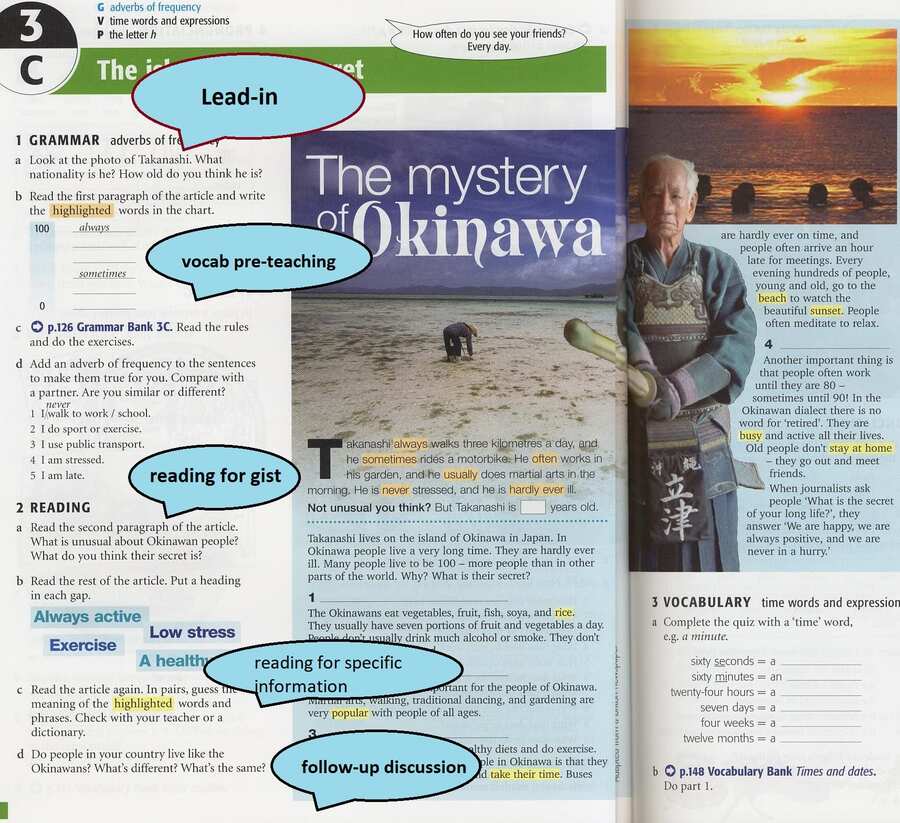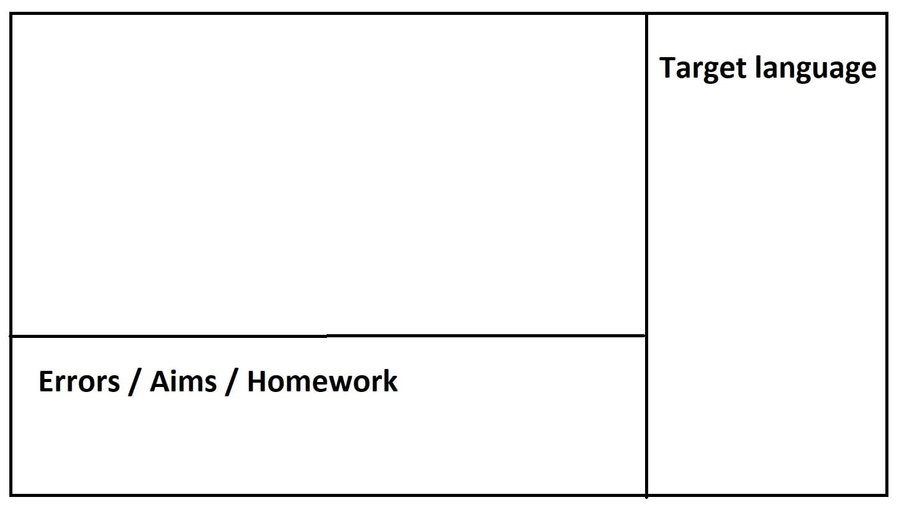ABC for beginning teachers (lesson planning, checklist and other materials)

As a beginner English teacher, it is crucial to develop certain skills to fully support the learning process of students. Lesson planning, boardwork, and error correction — all these skills are essential in the classroom and foster the successful and rapid development of the students.
In this article, we provide a simple but detailed guideline on how to improve your teaching skills and make ESL lessons organised, structured, and effective, even with little teaching experience.
Table of contents:
Lesson planning
An effective lesson plan helps the teacher to choose the materials, adapt the activities to the student’s needs, and be prepared for potential problems.
Step 1 — Identify the aims of the lesson
First, identify the type of the lesson: skills (listening, reading, writing, speaking) or systems (vocabulary, grammar, functions, pronunciation). Then, based on the desired outcomes, establish the main aims, sub-aims, and personal aims. For instance:
Type of Lesson: Grammar, Vocabulary, Functions, Reading, Listening, Writing, Speaking
Main Aim(s):
- To provide clarification and practice of humour related vocabulary in the context of an anecdote and self-quiz.
Sub-Aims:
- To enhance oral fluency on the topic of humour.
- To improve reading skills for gist and specific information on the topic of humour.
Personal Aims:
- To maintain consistent monitoring.
- To give clear instructions.
- To improve boardwork.
Step 2 — Predict potential problems in the lesson
Secondly, list any potential problems that learners might have with classroom management or with specific skills (speaking, writing, reading, listening). Consider how you would address these potential problems with classroom management.
For example:
| PROBLEM | SOLUTION |
|---|---|
| There might be an odd number of students, which will make pair work problematic. | I will ask some students to work in groups of three and make sure to change them, so that they had equal opportunities |
| There might be some fast finishers. | I will monitor attentively and when I see a fast finisher, I will give an extra task to them (see the tasks in the procedure). |
| Some words might be unknown for sts. | I will pre-teach blocking vocabulary after reading for gist. |
| Some sts might want to read for detail and understand all the words while reading the text for the first time | I will give clear instructions and ask ICQs (See the procedure).I will also tell the sts not to worry if they do not understand all the words. |
Step 3 — Plan the stages and activities of the lesson
Here are some lesson frameworks for skill and system lessons.
Receptive skills lessons (reading and listening):
2. Vocabulary pre-teaching (optional) — to pre-teach blocking vocabulary needed for gist reading / listening;
3. Reading/listening for gist or specific information — to set a short, easier task based on general understanding of the text as a whole.
4. Vocabulary pre-teaching (optional) — to teach any vocabulary needed for the detailed task.
5. Reading/listening for detailed comprehension — to set a task based on detailed comprehension (formats might include gap fills, ordering events, true/false, etc).
6. Follow up activity — to do a speaking/writing activity based on the text.

Productive skills lessons (writing and speaking):
2. Vocabulary pre-teaching — to pre-teach any key vocabulary.
3. Reading/Listening (optional) — to provide a model of the text type.
4. Focus on the layout — to present or elicit the layout.
5. Focus on the language — to present or elicit the vocabulary.
6. Controlled practice (optional) — to practise using the vocabulary.
7. Freer practice — for students to produce their own writing / speaking.
8. Feedback to content — to provide the evaluation of the ideas of writing / speaking.
9. Feedback to language — to provide error correction, to highlight good language usage as well!
Systems lessons (vocabulary, grammar, functions, pronunciation):
2. Reading/listening for gist — to provide reading / listening practice for general understanding.
3. Highlighting TL (target language) — to practise noticing skills.
4. Focus on the meaning — to clarify the meaning of TL.
5. TL analysis — to highlight the form.
6. Controlled practice — to practise using TL.
7. Freer practice — to practise speaking for fluency.
8. Feedback to content — to provide the evaluation of the ideas of writing/speaking.
9. Feedback to language — to provide error correction, to highlight good language usage as well!
Lesson frameworks will differ if you use TTT approach (test-teach-test), TBL (task-based learning) or others. Don’t hesitate to adapt the materials.
Step 4 — Double check everything
Use this checklist to see if your lesson plan is done:
— Do the procedure aims help me achieve the main aim of the lesson in a relatively coherent manner?
— Do the stages have transitions?
— Do I have enough time for each stage?
— Have I allowed enough time for feedback/learner questions if needed?
— Have I varied the interaction by including appropriate interaction patterns, such as pairwork/groupwork, so that the lesson is not monotonous?
— What can I do if activity X does not go the way I have planned? (see anticipated difficulties and problems and revise/add)
— Do I have feedback after each activity?
— Do I have quieter activities before lively ones?
— Do I end on a positive note?
Here’s a lesson plan template you can use.
Read as well:
Observation checklist
When you just start teaching, what is really beneficial is to observe your colleagues’ lessons. Here is a checklist of areas you should pay attention to and analyse (both positive and negative aspects).
1. Classroom management:
- TTT: Adjusting teacher’s own use of language in the classroom according to the learner group, speaking at a moderate pace, projecting the voice well, and balancing TTT-STT appropriately.
- Appropriate L1 usage (no more than 30% of TTT in L1 for Beginners).
- Rapport, eye contact, body language, and positioning.
- Using a variety of effective interaction patterns (S, S-S, T-S, T-Ss).
- Giving clear instructions (and effective instruction-checking questions if needed).
- Monitoring learners (checking in with students immediately after giving the task, helping students who struggle to complete the task, and not interrupting pair work unnecessarily).
- Managing materials and boardwork (keeping the board neat and helpful for students to understand and remember the material).
- Providing appropriate feedback and error correction (on content and language).
- Beginning and finishing lessons on time.
2. Lesson planning:
- Selecting, adapting, and designing materials, activities, resources, and technical aids according to the aims of the lesson and students’ needs.
- Ensuring balance, variety, and communicative focus in tasks.
- Logically ordering the lesson stages and activities.
- Allocating appropriate timing for different stages of the lesson.
- Ensuring smooth transitions between activities and stages of the lesson.
- Anticipating potential difficulties in the lesson and suggesting solutions to them (check Learner English for common problems).
3. Teaching skills and language:
- Helping students understand reading and listening texts.
- Helping students develop oral fluency.
- Helping students improve writing skills.
- Setting a clear context.
- Conveying meaning clearly from context.
- Using a range of questions to elicit and check understanding.
- Providing accurate and appropriate models of oral and written language.
- Clarifying meaning, form, and phonology to an appropriate depth.
- Showing awareness of differences in register.
- Providing appropriate practice of language items.
- Pair checking.
4. Learners:
- Teaching a class with awareness of the needs, interests, backgrounds, and learning styles of the students.
- Establishing good rapport with the students and ensuring their involvement.
- Maintaining an appropriate attitude towards latecomers (accommodating them if possible and not letting them interrupt the flow of the lesson).
- Working with fast finishers.
You can find a template for observations here. Also, use this self-evaluation sheet to “observe” your own lessons.
Tips for better boardwork
- Plan ahead to avoid writing target language twice or erasing important information. Divide your board into sections, including areas for new vocabulary, presentation, and homework. Avoid overcrowding and wipe unnecessary language.

- Keep your board neat with readable handwriting and clear, big letters.
- Use consistent colour coding to highlight different types of information, such as mistakes or pronunciation.
- Print words or phrases and stick them up when necessary to save time. Write on the board while students work on other tasks.
- Ensure all students have a clear view of the board and avoid blocking anyone’s sight.
- Practise quick sketches to illustrate vocabulary and activities. Draw in shapes.
Error correction
Students shouldn’t be afraid of using the wrong tense or omitting an article, as making mistakes is proof of learning, but the question is how teachers handle these mistakes. What should we correct, when should we correct it, and how should it be corrected?
Step 1 — Identify the reason for making mistakes
- L1 interference — happens when the learner’s mother tongue affects their performance in the target language. For example, learners make grammatical mistakes because they apply the same patterns as in their L1.
Read more about this in Learner English, a practical reference guide that compares the relevant features of a student’s language with English. It helps teachers predict and understand the problems their students face. The guide has chapters focusing on major problems of pronunciation, grammar, vocabulary, and other errors.
- Developmental errors — occur naturally as part of the learning process when a learner attempts to say something beyond their language level.
- Overgeneralization of a rule — the process of extending the application of a rule to items that the language norm excludes.
- Fossilised errors — happen when incorrect language becomes a habit and is challenging to correct.
- Slips — mistakes made by a learner because they are not attentive or are tired.
- The nature of English — some set collocations and idiomatic expressions may cause errors.
- Bad models — students learn poor examples and incorrect language from various available resources.
Step 2 — Choose the best time to correct (when)
- Hot correction — correct errors as soon as you notice a student making them.
- Cold correction (delayed error correction) — to avoid interrupting the learner during speaking activities, focus on monitoring and recording their language. Then, correct errors after the activity or at the end of the lesson when you can dedicate more time to error correction.
Step 3 — Choose an error correction technique (how)
Non verbal:
- Finger correction — use fingers to show the mistake in the sentence.
- Gestures — use gestures to show when students make mistakes. For example, gesture backward with your hands to show students they didn’t use the past tense. For incorrect pronoun use, point to themselves with a look of shock or surprise.
- Facial expressions — use exaggerated facial expressions to signal a mistake.
- Cards (visual reminders) — some students often omit “-s”, “be”, etc. You can prepare a card with a big “S” or “AM/IS/ARE” and raise it every time students make this mistake.
- Visual analysis — write the sentence on the board and highlight indicators, question marks, everything that might help the student correct the mistake, e.g.:
Verbal:
- Repeat up to the error — repeat the whole sentence up to the error and make a pause, waiting for the student to say the correct word/phrase. If the student has difficulty correcting the mistake, give options.
- Demonstrate more examples — elicit or demonstrate more sentences with the same vocabulary or constructions.
- Echoing — echo the mistake with emphasis on the mistake.
- Recast — reformulate the utterance into a correct version (emphasising the place of the mistake) and encourage to continue the conversation.
ELT glossary
A list of essential English language teaching (ELT) terminology.
Chant: A repetitive phrase, verse, or song used to practise pronunciation and vocabulary.
Classroom management: The process of organising the classroom, activities, and learners, including seating arrangements and managing interaction patterns.
Concept checking questions (CCQ): Questions used to confirm a learner’s understanding of a new language.
Content and Language Integrated Learning (CLIL): An approach to teaching non-language subjects, such as science or geography, in a target language.
Fossilisation: When incorrect language becomes a habit that’s difficult to correct.
Guided discovery (GD): An approach where the teacher provides examples of the target language and guides learners to work out the rules for themselves.
Ice-breaker: An introductory speaking activity that helps learners get to know each other.
Interaction patterns (IP): The different ways learners and teachers interact in class, such as in pairs, groups, or open class.
Jigsaw listening/reading: A communicative listening or reading activity where learners share information to gain a complete understanding.
L1: A learner’s first language or mother tongue.
Learner autonomy: When learners can set their own goals and organise their own study.
Mingle: An activity where learners walk around the classroom to complete a task.
Presentation, Practice, and Production (PPP): An approach to teaching a new language that involves presenting, practising, and producing the language in a communicative way.
Rapport: The relationship between the teacher and learners.
Recast: To reword a sentence or phrase to improve it.
Scaffolding: Temporary support teachers provide to help learners do a task, communicate, or understand.
Settler: An activity used to calm learners after a lively activity.
Student talking time (STT): The time learners spend speaking in a lesson.
Target language (TL): The language focused on in a lesson, such as grammar or vocabulary.
Task-based learning (TBL): An approach where the teacher asks learners to do a task with an achievable result.
Teacher talking time (TTT): The time the teacher spends talking in a lesson.
Test-teach-test (TTT): An approach where learners are tested on a topic before and after instruction.
Total Physical Response (TPR): a teaching method where the teacher gives instructions in the target language and the learners physically respond by carrying out the actions. For example, if the teacher says “stand up”, the learners stand up.
YLE: Young Learners English coursework or Young Learners English test.
Remember: a prepared teacher makes a confident teacher!















 Анна Тетерина
Анна Тетерина 
 Элизабет Мунтян
Элизабет Мунтян 

 Мария Нифонтова
Мария Нифонтова 
 Юлия Белоног
Юлия Белоног